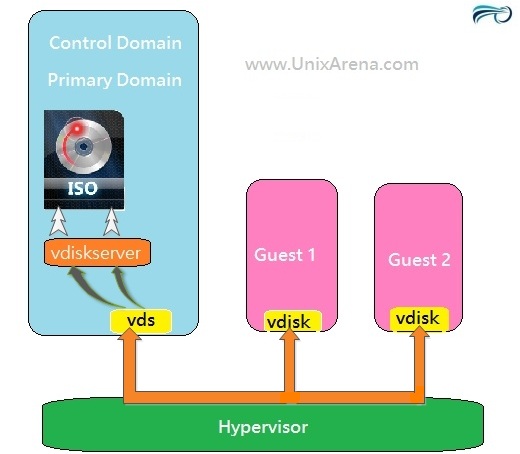In oracle VM for SPARC (LDOM), you need to attach the ISO file to each logical domain, for the first time operating system installation. If you have pre-configured jumpstart , You can use it for the guest domain operating system installation. If you don’t have jumpstart,then you need to install it using the ISO image. By default LDOM will not allow to map the same device file to multiple guest domains .Here we will see how we can map the same ISO image to multiple LDOMS.
Oracle VM for SPARC Tutorial:
[checklist]
- Installation and Configuring the Primary domain
- Creating Guest Domains
- Configuring I/O Domain
- Dynamically adding/removing Resources
- Live Migration for Guest Domains
- Adding ISO image to Multiple Guests (You Are Here)
- Configuration Backup & Restore
- Removing the LDOM and Services
[/checklist]
1. Login to the control domain and list the ISO image which you need to map it to ldoms.
# ls /export/home/sol-10-u10-ga2-sparc-dvd.iso sol-10-u10-ga2-sparc-dvd.iso
2.List the available services. Create a new virtual device for the virtual disk server using the below command.
-bash-3.2# ldm list-services
VCC
NAME LDOM PORT-RANGE
primary-vcc0 primary 5000-5100
VSW
NAME LDOM MAC NET-DEV ID DEVICE LINKPROP DEFAULT-VLAN-ID PVID VID MTU MODE
primary-vsw0 primary 00:14:4f:fa:fe:49 e1000g0 0 switch@0 1 1 1500
VDS
NAME LDOM VOLUME OPTIONS MPGROUP DEVICE
primary-vds0 primary vol1 /dev/zvol/dsk/pool1/vol1
clonevol1 /dev/zvol/dsk/pool1/clonevol1
vol0 /dev/dsk/c2t600144F0B8E706DA00005300F47B0007d0s2
vol10 /dev/dsk/c2t600144F0C1135B4900005303839A0002d0s2
# ldm add-vdsdev options=ro /export/home/sol-10-u10-ga2-sparc-dvd.iso newiso@primary-vds0
-bash-3.2# ldm list-services
VCC
NAME LDOM PORT-RANGE
primary-vcc0 primary 5000-5100
VSW
NAME LDOM MAC NET-DEV ID DEVICE LINKPROP DEFAULT-VLAN-ID PVID VID MTU MODE
primary-vsw0 primary 00:14:4f:fa:fe:49 e1000g0 0 switch@0 1 1 1500
VDS
NAME LDOM VOLUME OPTIONS MPGROUP DEVICE
primary-vds0 primary vol1 /dev/zvol/dsk/pool1/vol1
clonevol1 /dev/zvol/dsk/pool1/clonevol1
vol0 /dev/dsk/c2t600144F0B8E706DA00005300F47B0007d0s2
vol10 /dev/dsk/c2t600144F0C1135B4900005303839A0002d0s2
iso0 ro /export/home/sol-10-u10-ga2-sparc-dvd.iso
3.Add the newly created virtual read-only iso image to guest domain.
-bash-3.2# ldm list-domain NAME STATE FLAGS CONS VCPU MEMORY UTIL UPTIME primary active -n-cv- SP 12 4128M 0.3% 5h 45m ua1 active -n---- 5000 8 4G 0.1% 58m ua2 active -n---- 5001 8 2G 0.0% 58m ua3 active -n---- 5002 4 1G 0.1% 30m -bash-3.2# ldm add-vdisk viso1 newiso@primary-vds0 ua1 -bash-3.2#
4.You can see that ISO file has been attached to the ua1 ldom.
-bash-3.2# ldm ls-bindings ldom1
NAME STATE FLAGS CONS VCPU MEMORY UTIL UPTIME
ldom1 bound ------ 5000 8 512M
DISK
NAME VOLUME TOUT ID DEVICE SERVER MPGROUP
vdisk1 vol1@primary-vds0 2 disk@2 primary
viso1 newiso@primary-vds0 0 disk@0 primary
5.When try to map the same iso virtual image to another domain, you will get below error.
-bash-3.2# ldm add-vdisk viso2 newiso@primary-vds0 ua2 The volume "newiso" is already in use.
6.To avoid the above error, you need to create a new virtual read-only ISO image again.
-bash-3.2# ldm add-vdsdev options=ro /export/home/sol-10-u10-ga2-sparc-dvd.iso newiso2@primary-vds0 -bash-3.2#
7.Add the second virtual iso image to the another LDOM using the below command.
-bash-3.2# ldm add-vdisk viso2 newiso2@primary-vds0 ua2
-bash-3.2#
-bash-3.2# ldm list-bindings ua2
NAME STATE FLAGS CONS VCPU MEMORY UTIL UPTIME
ua2 active -n---- 5001 8 2G 0.1% 1h 3m
DISK
NAME VOLUME TOUT ID DEVICE SERVER MPGROUP
vdisk1 ua1ldom2@primary-vds0 0 disk@0 primary
viso2 newiso2@primary-vds0 1 disk@1 primary
The same way you can map the same ISO file to N-number of guest domains.(6 and 7 ).
Hope this article is informative to you. Thank you for visiting UnixArena.

Leave a Reply